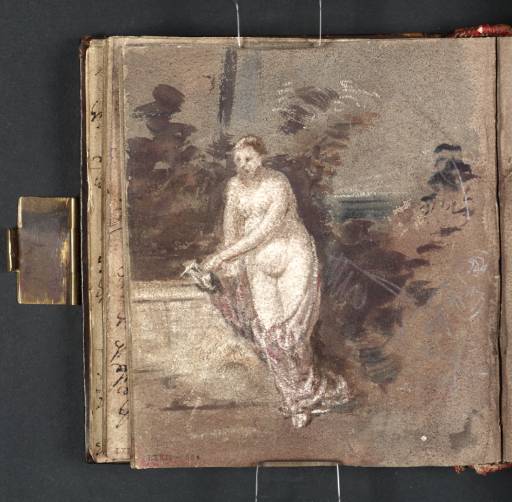Joseph Mallord William Turner Concert-champêtre, after Giorgione/Titian 1802
Joseph Mallord William Turner,
Concert-champêtre, after Giorgione/Titian
1802
Joseph Mallord William Turner 1775–1851
Folio 56 Verso:
Concert-champêtre, after Giorgione/Titian 1802
D04347
Turner Bequest LXXII 56a
Turner Bequest LXXII 56a
Pencil and watercolour, with some scratching out, on white wove paper prepared with a reddish grey wash, 128 x 114 mm
Stamped in black ‘LXXII–56a’ bottom right
Stamped in black ‘LXXII–56a’ bottom right
Accepted by the nation as part of the Turner Bequest 1856
References
1909
A.J. Finberg, A Complete Inventory of the Drawings of the Turner Bequest, London 1909, vol.I, p.190, LXXII 56a, as ‘Rough copy of Giorgione’s “Concert-Champêtre”’.
1961
Alexander J. Finberg, The Life of J.M.W. Turner, R.A. Second Edition, Revised, with a Supplement, by Hilda F. Finberg, revised ed., Oxford 1961, p.88.
1963
Jerrold Ziff, ‘Turner and Poussin’, The Burlington Magazine, vol.105, 1963, p.321 note 37.
1966
Jack Lindsay, Turner: His Life and Work, London 1966, p.78.
1971
Francis Haskell, ‘Giorgione’s Concert champêtre and its Admirers’, Journal of the Royal Society of Arts, London 1971, pp.543–55.
1983
Jerrold Ziff, ‘Turner et les grands maîtres’, in J.M.W. Turner, exhibition catalogue, Grand Palais, Paris 1983, p.28.
1987
Francis Haskell, ‘Giorgione’s Concert champêtre and its Admirers’, revised and reprinted in Past and Present in Art and Taste: Selected Essays, New Haven and London 1987, pp.141–53, 241 note 15.
1993
Jean-Pierre Cuzin and Marie-Anne Dupuy, Copier créer. De Turner à Picasso: 300 oeuvres inspirées par les maîtres du Louvre, exhibition catalogue, Musée du Louvre, Paris 1993, pp.80, 201.
2003
Ian Warrell, David Laven and others, Turner and Venice, exhibition catalogue, Tate Britain, London 2003, pp.54 reproduced fig.37, 262 note14.
The Louvre’s famous and mysterious allegory of music and love, a masterpiece of the Venetian tradition of figures in a landscape, was supposed to have belonged to the Gonzaga in Mantua and then to Charles I in London, before being certainly acquired by Louis XIV. It was long ascribed to Titian, then to Giorgione (Giorgio Barbarelli before 1477–1510), leaving the possibility that the copy after that painter listed in the inventory of contents then in Turner’s house but now untraced (Turner Bequest Schedule, 21 June 1854, no.315)1 was of this subject. It has since most often been given to Titian, while Charles Hope has recently suggested Domenico Mancini.2 Its old title of ‘Pastoral’ had changed to Concert-champêtre by the time the state museum opened at the Louvre in 1793. Its many admirers and copyists since are discussed by Haskell and also by Cuzin.3
Joseph Farington recorded in his diary for 5 October 4 seeing the picture – ‘a Titian which [Henry] Fuseli calls “the Loves of the Fountain”’ – taken down from the Salon carré to make way for the contemporary Salon. He also observed ‘Turner drawing’ – Warrell suggests making this copy. Turner’s copy continues on folio 57 of this sketchbook (D04348), and see also its verso (D04349) for his remarks on the picture. Haskell cited these as an early example of Romantic interest in its colouring and realistic portrayal of the body, but sensed that Turner was also embarrassed by its frank display of nudity. As Haskell thought the copy too faded to reproduce, his point was allowed to stand, but seems unlikely since in fact the drawing focuses in most detail on the nude figure at the fountain which indeed Turner described as both ‘charmingly colour’d and graceful’. Ziff 5 went so far as to suggest ‘incidentally’ that Turner borrowed the figure for one second from right in his picture The Goddess of Discord Choosing the Apple of Contention in the Garden of the Hesperides, 1806 (Tate N00477).6 The correspondence, however, is not exact. Finberg, followed by Cuzin, believed that Turner first made his Paris sketch in pencil and then coloured the figure from memory, at which point his rendering strayed somewhat from the original.
David Blayney Brown
July 2005
How to cite
David Blayney Brown, ‘Concert-champêtre, after Giorgione/Titian 1802 by Joseph Mallord William Turner’, catalogue entry, July 2005, in David Blayney Brown (ed.), J.M.W. Turner: Sketchbooks, Drawings and Watercolours, Tate Research Publication, December 2012, https://www

